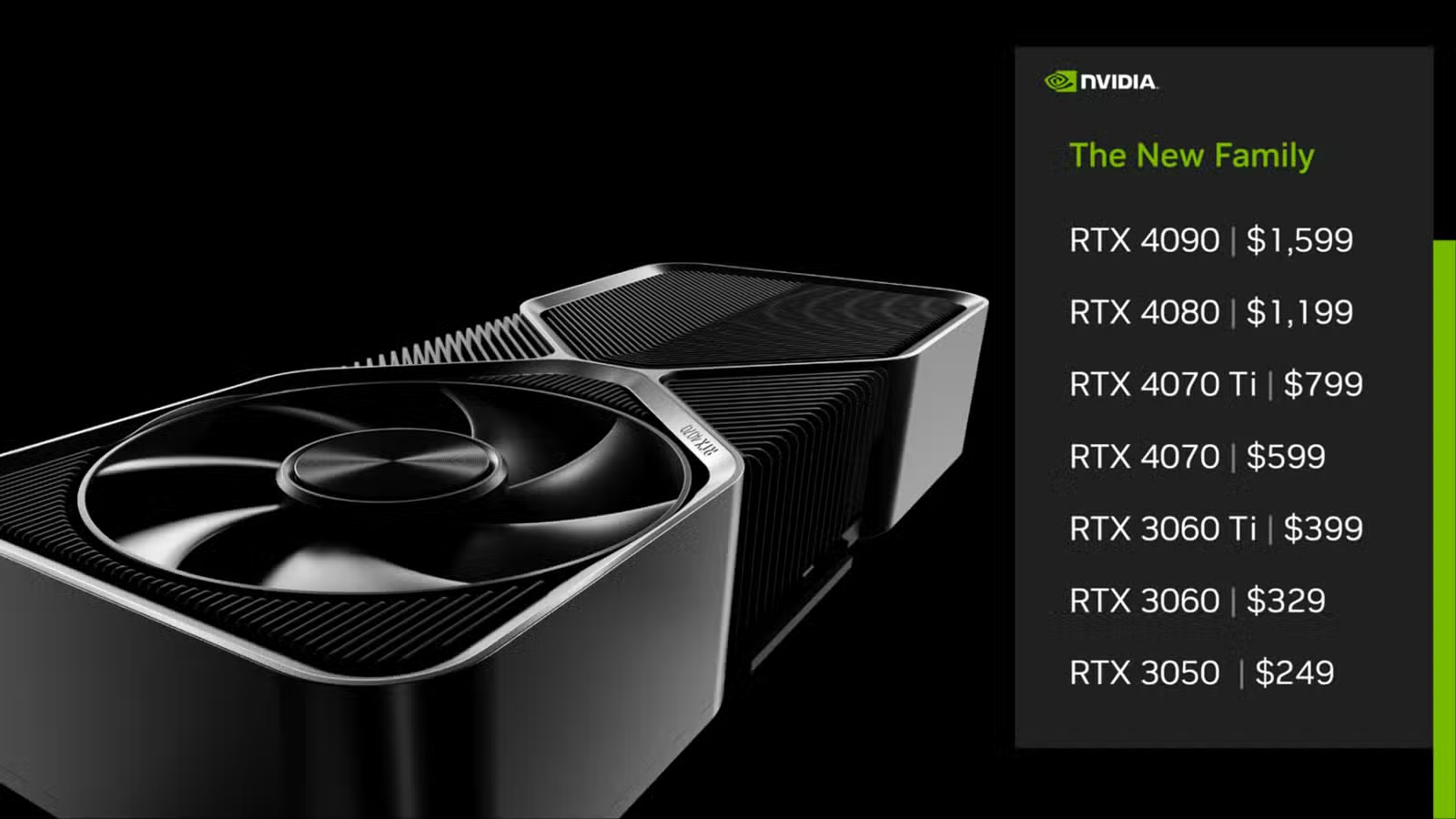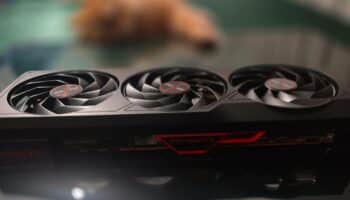The GeForce RTX 4080 is the least popular 40-series graphics card. Priced at $1,199, it’s notably slower than the RTX 4090 while offering 33% less memory and cache. We’re comparing the RTX 4080 against the RTX 4070, a $529 GPU that costs half as much but has been much more successful among gamers. This guide is for RTX 4070 owners considering an upgrade to the RTX 4080 or the RTX 4080 Super.
NVIDIA RTX 4070 vs 4080: Specifications
The GeForce RTX 4070 utilizes the AD104 die, whilst the RTX 4080 is based on the AD103 die. The latter has 9,728 shaders spread across 76 SMs, which is 65% higher than the former’s 5,888 cores (46 SMs). The RTX 4070 has 12GB of VRAM, compared to 16GB (+50%) on the RTX 4080. The 70-class GPU has a boost frequency of 2.475GHz, while its higher-end counterpart runs at more than 2.5GHz.
| RTX 4080 | RTX 4070 | |
|---|---|---|
| GPU | AD103 | AD104 |
| SMs/ RT Cores | 76 | 46 |
| Shaders | 9,728 | 5,888 |
| VRAM | 16 GB | 12 GB |
| L2 Cache | 64 MB | 36 MB |
| Memory bus | 256-bit | 192-bit |
| Memory Clock | 22.4 Gbps | 21 Gbps |
| Memory Bandwidth | 716.8 GB/s | 504.2 GB/s |
| GPU Boost Clock | 2,505 MHz | 2,475 MHz |
| TBP | 320W | 200W |
| MSRP | $1000+ | $529 |
The RTX 4070 has an external memory bandwidth of 504.2 GB/s and 36MB of L2 cache. The RTX 4080 has a max bandwidth of 716.8 GB/s (+42%) and 64MB of LLC.
Test Bench
- Motherboard: ASUS ROG Maximus Z790 Hero.
- CPU: Intel Core i9-13900K.
- Cooler: Lian Li Galahad 360.
- Memory: 16GB DDR5 x2 @ 6,000MT/s CL30.
- Power Supply: Corsair HX1000i.
Test Methodology
- We tested the GeForce RTX 4070 and 4080 on a Z790 motherboard running a Core i9-13900K with 32GB DDR5 memory.
- Eleven games were benchmarked at 1440p and 4K using the highest quality graphics preset, followed by the highest ray-tracing quality preset at 1440p.
- The performance is measured using the average FPS and 1% lows. The latter represents a figure higher than the lowest 1% frame rates. It’s used to gauge the performance in resource-intensive scenarios.
NVIDIA RTX 4070 vs RTX 4080: 1440p Gaming Benchmarks
A Plague Tale: Requiem
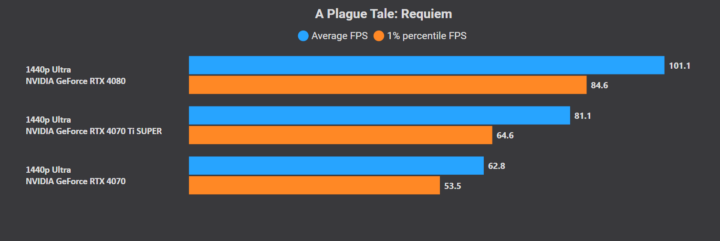
In “A Plague Tale: Requiem, ” the GeForce RTX 4080 averages 101.1 FPS up from 62.8 FPS on the RTX 4070. That’s a massive 60% deficit between the two GPUs at 1440p.
Assassins Creed: Valhalla
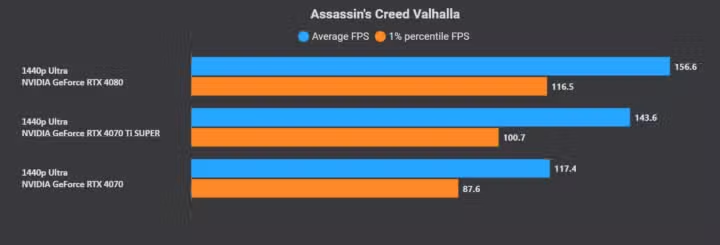
Assassins Creed: Valhalla is more CPU-bound, granting the RTX 4080 a more modest 33% lead over the RTX 4070. Both GPUs average over 100 FPS, so you won’t be able to tell them apart (at least not in most cases).
Cyberpunk 2077
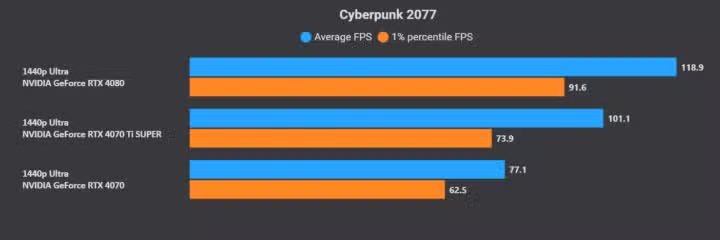
Cyberpunk 2077 is one of the most well-optimized games. It averages a healthy 118.9 FPS on the RTX 4080, up from 77 FPS on the RTX 4070. Once again, both SKUs have lows of over 60 FPS, with a 54% lead for the former.
Dying Light 2
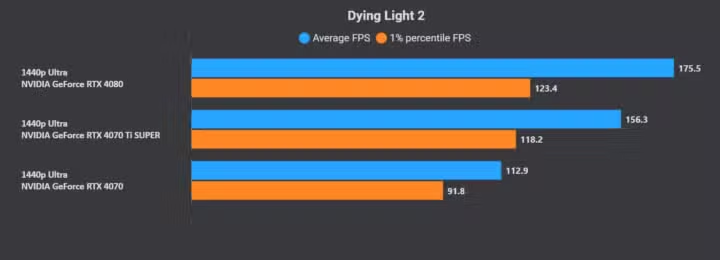
Dying Light 2 performs similarly, with an average of 175.5 FPS on the RTX 4080 versus 112.9 FPS on the RTX 4070. The lows are within 30 FPS of one another, indicating ample scaling.
F1 2022
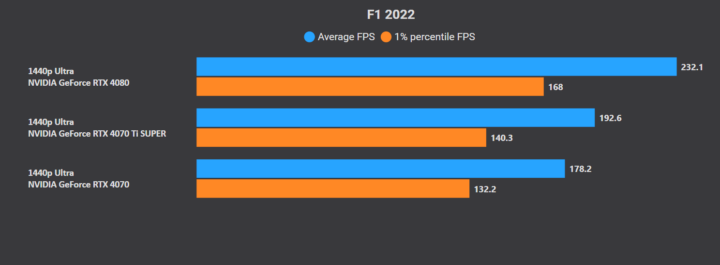
F1 2022 produces an average of 232 FPS on the GeForce RTX 4080, up from 178 FPS on the RTX 4070. Despite such high frame rates, the game remains GPU-bound with lows of 130+ FPS on the two cards
Ghostwire: Tokyo
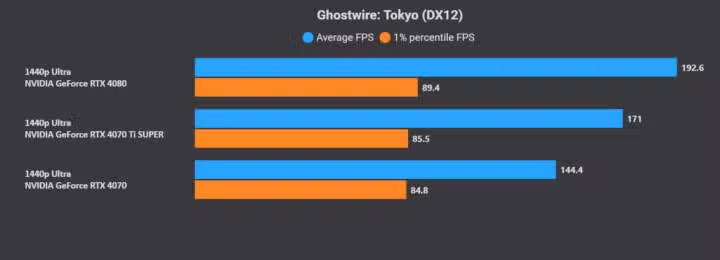
Ghostwire: Tokyo is 33% faster on the RTX 4080 with an average of 192.6 FPS, versus 144.4 FPS on the RTX 4070. The lows are almost similar which is the result of unoptimized game code, as there’s no CPU bottleneck.
Hitman 3
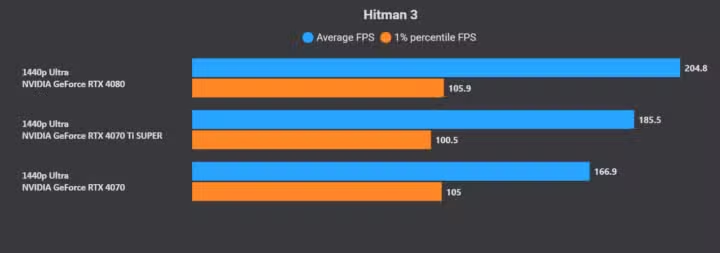
Hitman 3 runs at a solid 204.8 FPS on the RTX 4080, comfortably beating its sibling by 23%. Once again, the lows are nearly identical, but this time the game is more CPU-bound.
Hogwarts Legacy
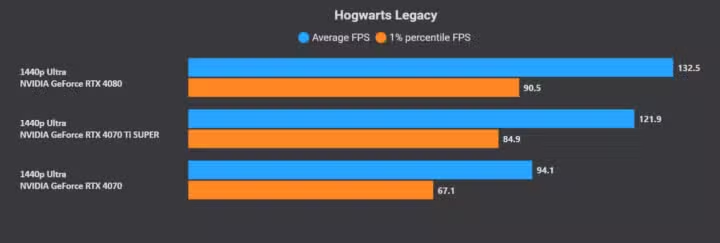
Shadow of the Tomb Raider
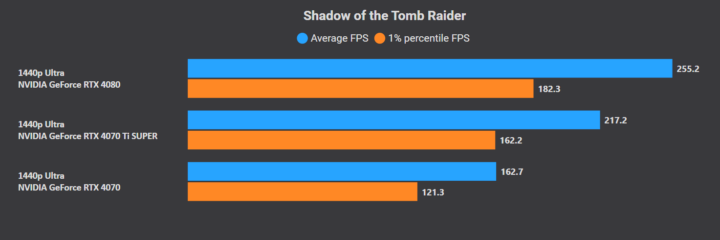
Shadow of the Tomb Raider runs 55% faster on the GeForce RTX 4080, averaging 255 FPS, up from 162.7 FPS on the RTX 4070. Unlike the last few titles, we see a 50% deficit in the lows as well.
The Callisto Protocol
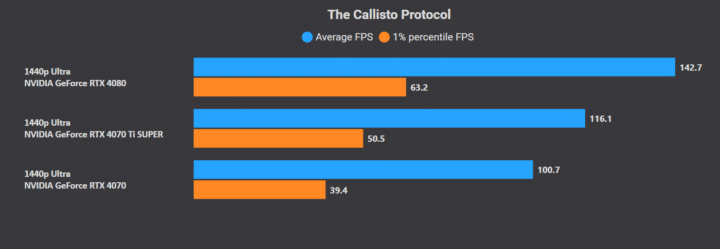
The Callisto Protocol runs quite well on both GPUs, averaging 142.7 FPS on the RTX 4080, versus 100.7 FPS on the 4070. Once again, the lows are 50% higher on the former.
Tiny Tina’s Wonderlands

Tiny Tina’s Wonderlands expands the delta between the 4070 and 4080 to 63.6%. Even the deficit in lows is over 60% wide.
Average 1440p Gaming Performance
At 1440p, the GeForce RTX 4080 is over 42% faster than the RTX 4070 on average. Across our 11-game benchmark, it averaged 172.23 FPS compared to 120.79 FPS for the 4070. Both GPUs stay over 100 FPS, but the RTX 4080 goes a step further approaching or crossing 200 FPS in half of the games.
| Game | NVIDIA RTX 4070 (Avg FPS) | NVIDIA RTX 4080 (Avg FPS) |
|---|---|---|
| A Plague Tale | 62.8 FPS | 101.1 FPS |
| Assassin’s Creed: Valhalla | 117.4 FPS | 156.6 FPS |
| Cyberpunk 2077 | 77.1 FPS | 118.9 FPS |
| Dying Light 2 | 112.9 FPS | 175.5 FPS |
| F1 2022 | 178.2 FPS | 232.1 FPS |
| Ghostwire: Tokyo | 144.4 FPS | 192.6 FPS |
| Hitman 3 | 166.9 FPS | 204.8 FPS |
| Hogwarts Legacy | 94.1 FPS | 132.5 FPS |
| Shadow of the Tomb Raider | 162.7 FPS | 255.2 FPS |
| The Callisto Protocol | 100.7 FPS | 142.7 FPS |
| Tiny Tina’s Wonderlands | 111.5 FPS | 182.5 FPS |
| 11 Game Average | 120.79 FPS | 172.23 FPS (+42.59%) |
The Conclusion: If you have a 1440p 120Hz display, then stick to the 4070. The 4080 only makes sense if you play at 144Hz or higher.
NVIDIA RTX 4070 vs RTX 4080: 4K Gaming Benchmarks
The pixel count gets more than doubled at 4K, from <4 million at 1440p to 8.3 million. The higher memory bandwidth of the RTX 4080 comes in handy as the memory usage gets higher and higher. The L2 cache acts as the first line of defense, reducing the load on the memory bus.
A Plague Tale: Requiem
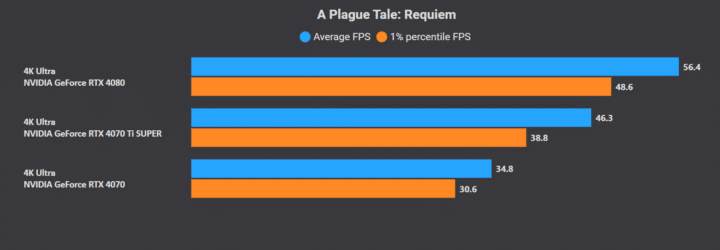
A Plague Tale Requiem is a whopping 62% faster on the RTX 4080, averaging 56.4 FPS, up from a paltry 34.8 FPS on the RTX 4070. We see a similar deficit in the lows.
Assassin’s Creed: Valhalla
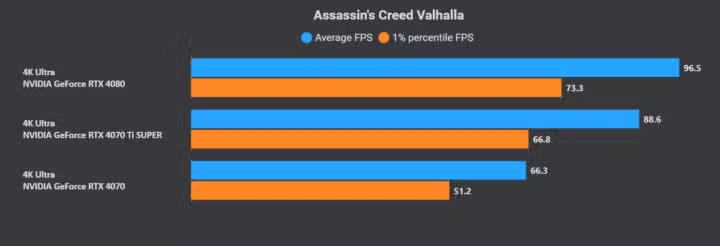
Cyberpunk 2077
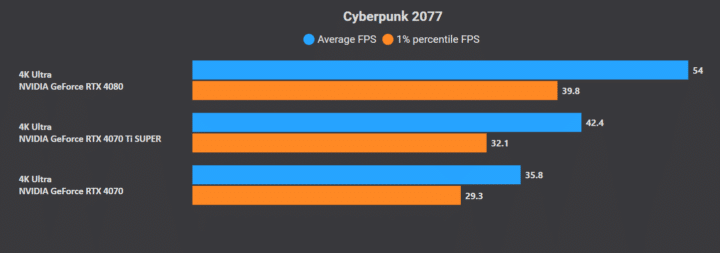
Dying Light 2

Dying Light 2 increases the performance delta between the RTX 4070 and 4080 to 75% with averages of 55.2 FPS and 96.1 FPS, respectively. The lows are even farther apart, with a gulf of 79%.
F1 2022

Ghostwire: Tokyo

Ghostwire Tokyo scales better at 4K. It produces an average FPS of 101.9 on the RTX 4080, making it 70% faster than the 4070 locked at 60 FPS. The lows are twice as high on the 4080, indicating a memory bottleneck on the slower GPU.
Hitman 3
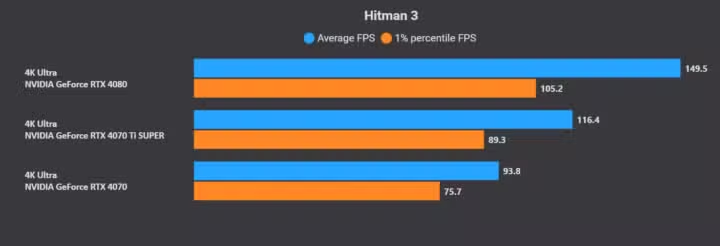
Hogwarts Legacy
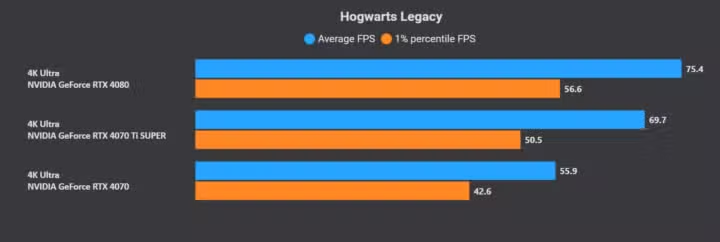
Hogwarts Legacy is only 34% faster on the GeForce RTX 4080 at 4K. It produces an average FPS of 75.4, versus 56 FPS on the 4070.
Shadow of the Tomb Raider

Shadow of the Tomb Raider averages 142.5 FPS on the RTX 4080 at 4K, making it 70% faster than the 4070 which averages 83.5 FPS. A similar deficit is felt in the lows.
The Callisto Protocol

The Callisto Protocol averages 86.5 FPS on the RTX 4080 with lows of 33.9 FPS. The 4070, on the other hand, falls short of 60 FPS with 20 FPS lows.
Tiny Tina’s Wonderlands

Average 4K Gaming Performance
At 4K, the GeForce RTX 4070 continues to deliver over 60 FPS (average) in most titles but falls short in a few. Moreover, the RTX 4080 expands its lead over the 4070 to 56%, delivering nearly 100 FPS or more in 8 out of 11 games.
| Game | NVIDIA RTX 4070 (Avg FPS) | NVIDIA RTX 4080 (Avg FPS) |
|---|---|---|
| A Plague Tale | 34.8 FPS | 56.4 FPS |
| Assassin’s Creed: Valhalla | 66.3 FPS | 96.5 FPS |
| Cyberpunk 2077 | 35.8 FPS | 54 FPS |
| Dying Light 2 | 55.2 FPS | 96.1 FPS |
| F1 2022 | 111.7 FPS | 163.7 FPS |
| Ghostwire: Tokyo | 60.3 FPS | 101.9 FPS |
| Hitman 3 | 93.8 FPS | 149.5 FPS |
| Hogwarts Legacy | 55.9 FPS | 75.4 FPS |
| Shadow of the Tomb Raider | 83.5 FPS | 142.5 FPS |
| The Callisto Protocol | 58.5 FPS | 86.5 FPS |
| Tiny Tina’s Wonderlands | 60.4 FPS | 96.6 FPS |
| 11 Game Average | 65.11 FPS | 101.74 FPS (+56%) |
The Conclusion: The GeForce RTX 4080 is miles ahead of the 4070 at 4K. The averages, lows, and frame pacing make it the obvious choice for 4K gaming. The RTX 4070 does well in most games but suffers from low frametimes and micro stuttering in more than a few titles.
NVIDIA RTX 4070 vs RTX 4080: Ray Tracing Benchmarks
Ray tracing is significantly more taxing on GPUs, especially increasing the register and cache usage for BVH structures generation. The NVIDIA RTX 4080 holds a dominant position in these tests, oft beating the RTX 4070 by 50% or more. We tested the following games using the highest ray-tracing preset at 1440p native, without any upscaling or frame generation.
A Plague Tale: Requiem
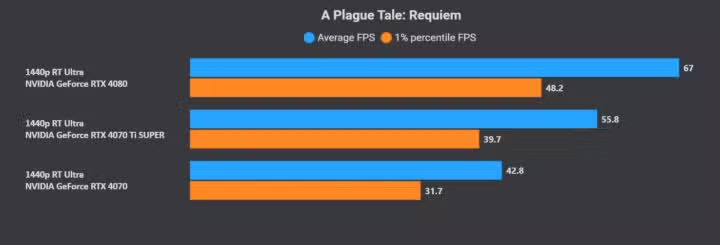
A Plague Tale: Requiem features ray-traced shadows. With these enabled, the RTX 4080 is 55.5% faster than the RTX 4070, though the lows are a closer affair.
Cyberpunk 2077
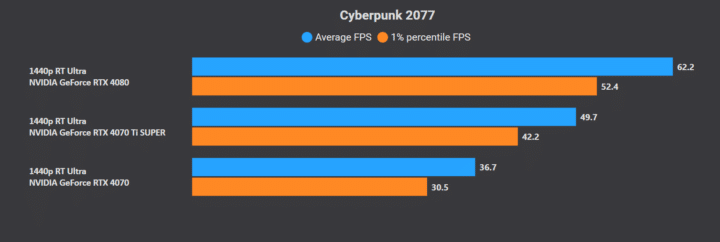
Cyberpunk 2077 increases the performance deficit between the RTX 4070 and 4080 to 69%, with an average of 62 FPS on the latter. The 70-class card fails to hit 40 FPS with 30 FPS lows.
Crysis Remastered

Dying Light 2
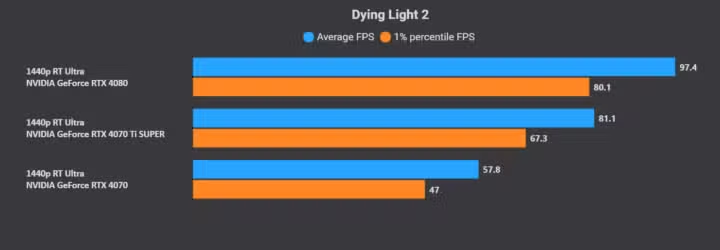
Dying Light 2 produces a similar gulf between the two graphics cards. The RTX 4080 runs at an average of nearly 100 FPS, while the 4070 fails to hit 60. We see a delta of 70% between the lows, with one at 40 and the other at 80.
F1 2022
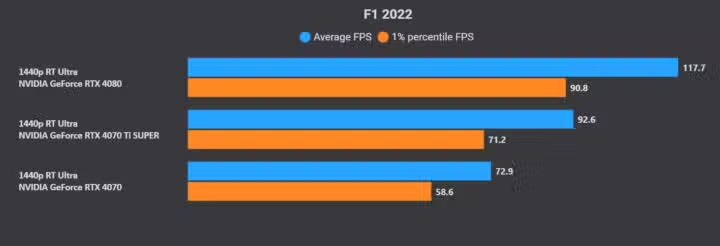
Hitman 3

F1 2022 shows a performance deficit of 61% between the two GPUs, while Hitman 3 increases it to 65%. The GeForce RTX 4080 runs at 76 FPS while the 4070 manages an average of 46. The lows are nearly 2x higher on the former, again a sign of a memory/cache bottleneck.
Hogwarts Legacy
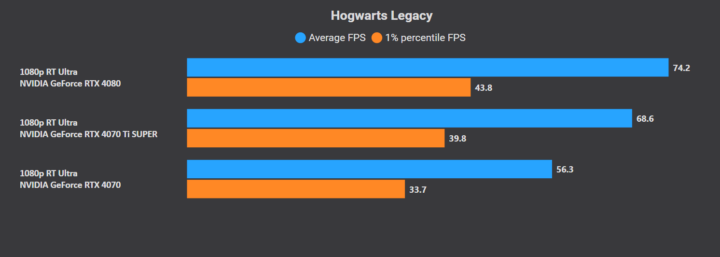
Hogwarts Legacy refused to run at 1440p (with ray-tracing) on the RTX 4070, likely a VRAM limitation. We tested the game at 1080p, where the RTX 4080 averaged 74 FPS, versus 56 FPS on the 4070.
Ghostwire: Tokyo
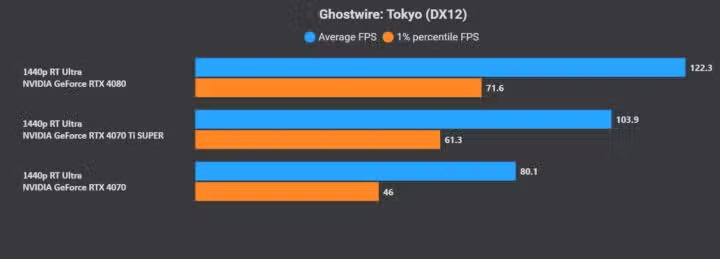
Metro Exodus

Shadow of the Tomb Raider
Shadow and the Tomb Raider and Metro Exodus are both over 60% faster on the GeForce RTX 4080, averaging 89 FPS and 181 FPS, respectively. The RTX 4070 yields 54 FPS in Metro and 110 FPS in Shadow, with the lows dropping to 36 FPS in the former.

The Callisto Protocol
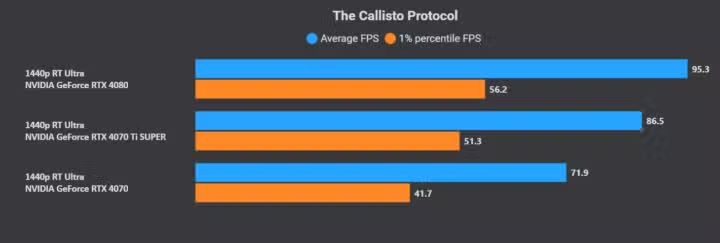
The Callisto Protocol runs poorly with ray-tracing. The RTX 4080 averages 95 FPS with lows of 56 (close to half as much). The RTX 4070 nets an average of 72 FPS, while dropping to 42 FPS now and then. Such a stark difference between the average and lows is usually the result of poor optimization or a memory bottleneck.
Average Ray Tracing Performance
With ray-tracing thrown into the mix, the GeForce RTX 4080 becomes 57% faster than the 4070 on average. It averages well over 60 FPS in almost every game, netting close to 100 FPS or more in 7 out of 11 titles. The RTX 4070 produces a respectable 67 FPS on average but drops below 60 in 6 out of 11 scenarios.
| Game | NVIDIA RTX 4070 (Avg FPS) | NVIDIA RTX 4080 (Avg FPS) |
|---|---|---|
| A Plague Tale | 42.8 FPS | 67 FPS |
| Crysis Remastered | 36.7 FPS | 62.2 FPS |
| Cyberpunk 2077 | 111.8 FPS | 168 FPS |
| Dying Light 2 | 57.8 FPS | 97.4 FPS |
| F1 2022 | 72.9 FPS | 117.7 FPS |
| Ghostwire: Tokyo | 80.1 FPS | 122.3 FPS |
| Hitman 3 | 46.3 FPS | 76 FPS |
| Hogwarts Legacy | 56.3 FPS | 74.2 FPS |
| Metro Exodus | 53.7 FPS | 88.9 FPS |
| Shadow of the Tomb Raider | 110.2 FPS | 180.2 FPS |
| The Callisto Protocol | 71.9 FPS | 95.3 FPS |
| 11 Game Average | 67.32 FPS | 105.59 FPS (+57%) |
The Conclusion: The GeForce RTX 4070 is a capable ray-tracing GPU, but its smaller L2 cache and memory make it more suited for ray-tracing workloads at 1080p or upscaled 1440p. The RTX 4080, on the other hand, puts up a stellar show with triple-figure averages in half of the tests.
Thermals and Power Consumption
The GeForce RTX 4080 has a TBP of 320W, 60% higher than the 200W power limit of the RTX 4070. Interestingly, the former doesn’t utilize its entire power budget, stopping at 300W in most cases. It was recorded to be the highest in Hitman 3 at 4K. The RTX 4070 is more power-bound, regularly hitting its power limit at 4K.
| GPU | Peak Temp (C) | Peak power (W) | TBP |
|---|---|---|---|
| NVIDIA RTX 4080 | 69C | 309W | 320W |
| NVIDIA RTX 4070 | 70C | 203W | 200W |
NVIDIA GeForce RTX 4070 vs RTX 4080: Conclusion
The GeForce RTX 4070 is an excellent 1440p graphics card, delivering 60+FPS in almost every game. However, 4K belongs to the RTX 4080 (and 4090). The 4070 falls short on memory bandwidth, with its 36MB LLC failing to meet the demands of 8 million pixels. You can still use the 70-class GPU for mild to moderate 4K gaming, especially when DLSS 3 is available. That said, the RTX 4080, being 56% faster than the 4070 at 4K, is a valid upgrade option for gamers looking to upgrade.
Further reading:
